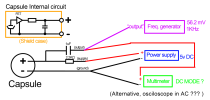Basically, I want to match mic capsules (pair those with similar sensitivity) without using sound.
I know that to do this more accurately, I would need an anechoic chamber to measure an acoustic signal, but the capsules are very sensitive (-25dB ± 3dB) and I don’t have an anechoic chamber. Building one to the proper standard seems difficult.
What I’m interested in is not knowing the exact sensitivity, but simply trying to match them. Could I do this without sound?
According to ChatGPT, I could calculate the relative sensitivity, which would give me an approximation to match them. It would be done with a frequency generator, a power supply, and a multimeter. Is this correct, or is it a waste of time?
The capsule works at 1.0V-10V(DC) and has an internal PET, resistor, and capacitor, with max impedance 2.2KΩ at 1KHz, and current consumption Max.0.5mA.
That 1µF capacitor and 2.2kΩ resistor are according to the manufacturer's test.
I’m a complete beginner, so sorry if this doesn’t make sense XD.
thanks.
I know that to do this more accurately, I would need an anechoic chamber to measure an acoustic signal, but the capsules are very sensitive (-25dB ± 3dB) and I don’t have an anechoic chamber. Building one to the proper standard seems difficult.
What I’m interested in is not knowing the exact sensitivity, but simply trying to match them. Could I do this without sound?
According to ChatGPT, I could calculate the relative sensitivity, which would give me an approximation to match them. It would be done with a frequency generator, a power supply, and a multimeter. Is this correct, or is it a waste of time?
The capsule works at 1.0V-10V(DC) and has an internal PET, resistor, and capacitor, with max impedance 2.2KΩ at 1KHz, and current consumption Max.0.5mA.
That 1µF capacitor and 2.2kΩ resistor are according to the manufacturer's test.
I’m a complete beginner, so sorry if this doesn’t make sense XD.
thanks.

